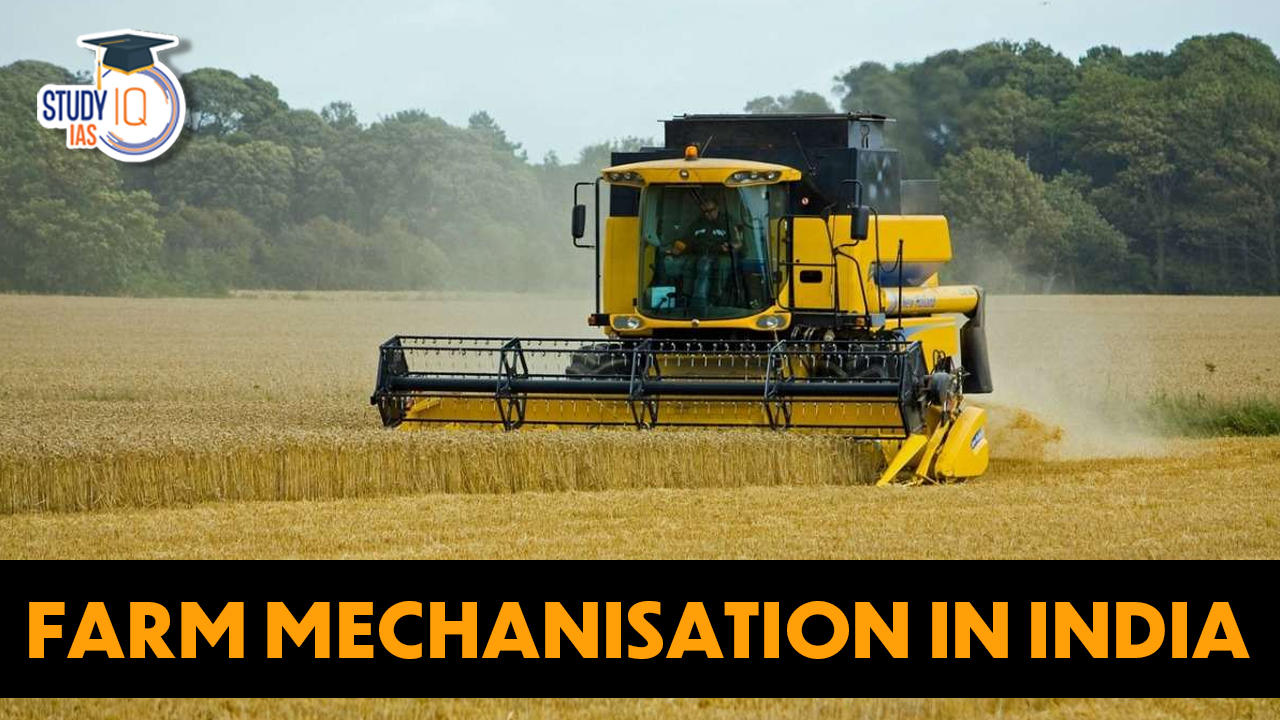Table of Contents
Context: The standing committee on agriculture, animal husbandry and food processing (2022-23) has released a report on ‘R&D in farm mechanisation for small and marginal farmers in the country’.
Key Highlights of the Report
- Currently, the overall agricultural mechanization level in the country is around 47% which is lower than that of other developing countries such as China (59.5%) and Brazil (75%).
- The report noted that between FY20 and FY23, the agriculture ministry allocated 30% less fund (Rs 217 crore in FY20 to Rs 179 crore in FY23) for R&D to farm mechanization scheme.
- The panel has urged the agriculture ministry to strive for achieving 75% in farm mechanization in a much shorter period than 25 years earlier.
- The government must increase investment in R&D for farm mechanization especially for the small and marginal farmers as it plays a critical role in increasing agricultural productivity, the report noted.
- The panel has noted that contribution of agricultural mechanization in India leads to saving in seed (15%-20%), fertilizer (15%-20%), cropping intensity (5%-20%), increase in crop yield (13%-23%), improvement in germination rate (7%-25%), labour cost (20%-30%).
What is Farm Mechanisation?
- Farm mechanization, also known as agricultural mechanization, is the process of utilizing machinery and equipment to replace or supplement human and animal labor in various agricultural activities.
- It involves the adoption of technology, such as tractors, harvesters, seeders, irrigation systems, and other automated tools, to perform tasks that were traditionally done manually.
- The primary goals of farm mechanization are to increase efficiency, productivity, and profitability in agriculture while reducing the physical burden on farmers.
- Additionally, mechanization can have a positive impact on sustainable agriculture practices by optimizing resource utilization and minimizing the environmental footprint of farming activities.
The Need for Mechanisation in Indian Agriculture
- Enhanced Productivity and Cost Reduction: Utilizing appropriate machinery can significantly boost farm productivity, potentially increasing yields by up to 30% while reducing input costs by approximately 20%.
- This becomes especially crucial for small landholders in India, where non-tractor farm equipment is better suited to cater to the needs of marginal farmers.
- Currently, about 86% of the total land holdings in India are in small and marginal size groups.
- Reduced Work Burden and Increased Efficiency: Most of the workforce in agriculture in India are females, and the usage of machines can reduce their work burden and increase their efficiency.
- Nearly 63% workers are female in the agriculture sector at the pan-India level, according to the annual Periodic Labour Force Survey (PLFS) Report 2021-22.
- Environmental Sustainability: Efficient use of land, water, and energy in mechanized farming contributes to environmentally responsible practices.
- Outward Migration of Educated Youth: Farm mechanization can also aid in outward migration of educated youth from the farm sector and help them to contribute better in other sectors.
- Addressing Escalating Labor Costs: The rising cost of labor for agricultural operations necessitates the adoption of farm mechanization to reduce labor expenses and overall cultivation costs.
- Mitigating Seasonal Labor Shortages: During peak agricultural seasons, there is often a shortage of available labor. Farm mechanization offers a reliable solution to cope with this labor scarcity.
- Improved Crop Quality: Mechanized equipment is designed to perform farming operations with precision and accuracy, leading to better crop quality.
- Precision Agriculture: Mechanization facilitates the adoption of precision agriculture techniques, including GPS-guided systems and data-driven decision-making, resulting in optimized resource allocation and reduced wastage.
Challenges for Farm Mechanisation in India
- Small and Fragmented Land Holdings: Small farmers face challenges in affording even minor farming equipment, making it difficult for them to adopt mechanization.
- High Initial Investment: Farm mechanization requires a significant upfront investment, which can be a deterrent for many farmers, especially those with limited financial resources.
- Low Awareness Among Farmers: A lack of awareness about different types of machinery and their proper usage hinders the adoption of mechanization.
- Quality and after-sales service: Since most of the equipment’s are made by unorganized sectors, there is inadequate quantity and quality of service Centres for proper maintenance.
- Absence of Industry-Specific Classification: The farming machinery industry lacks a specific National Industrial Classification Code (NIC Code), leading to products being scattered across various codes and not being recognized or classified as a distinct industry.
- The National Industrial Classification Code is a statistical standard for developing and maintaining a data base for various economic activities under a particular industry.
- Access to Finance: Limited access to credit and finance options for farmers to invest in mechanized equipment can hinder the widespread adoption of modern farming technologies.
- Adaptability to Local Conditions: Some farm machinery may not be well-suited for the diverse and challenging terrains and conditions found in different regions of India.
- Shortage of Skilled Workers: Fabrication of agricultural tools and machinery is often done by semi-skilled workers without proper tools, thereby reducing their quality and efficiency.
Government Initiatives
- Sub Mission on Agricultural Mechanization (SMAM): It’s a Centrally Sponsored scheme, launched by the Government of India in 2014-15.
- The scheme aims at ‘reaching the unreached’ by making farm machines accessible and affordable for small and marginal farmers (SMFs) through the establishment of Custom Hiring Centers (CHCs), creating Hubs for hi-tech & high-value farm equipment, and Farm Machinery Banks.
- Under this scheme, financial assistance @ 40% to 50% of the cost of machines depending on the categories of farmers, is provided for purchase of agricultural machines.
- Farm Mechanisation is integrated as a key objective in schemes such as:
- Rashtriya Krishi Vikas Yojana (RKVY),
- National Food Security Mission,
- Mission for Integrated Development of Horticulture,
- National Mission on Oilseeds and Oil Palm.
Way Forward
- Long-term Action plan: A long term vision to make India a production and export hub for non-tractor farm equipment’s, along with an efficient action plan to tackle the current challenges.
- Indigenization: Make in India can be used to support local manufacturing of farm implements currently being imported.
- CSR Funding: Corporate Social Responsibility (CSR) funds can be used for the capacity-building initiative in the farm equipment space as well as promoting a sustainable agricultural ecosystem.
- Streamlining Financing Options: The government can work with financial institutions to ensure hassle-free access to credit for purchasing farm equipment.
- Public-Private Partnerships (PPPs): Encouraging PPPs in the farm mechanization sector can bring together the strengths of the government, private enterprises, and farmer cooperatives.
- Skill Development and Training: Comprehensive training programs should be initiated to equip individuals with the necessary expertise in manufacturing, servicing, and operating modern farm machinery.
- Institutionalized Framework for CHCs: The unorganized sector of Custom Hiring Centers (CHCs) should be integrated into a well-structured institutional setup. This could involve the establishment of cooperatives or associations, providing them with access to formal credit, technology, and training to enhance their efficiency and service quality.


 Editorial of the Day (17th May): Right t...
Editorial of the Day (17th May): Right t...
 Supreme Court Judgement on Private Prope...
Supreme Court Judgement on Private Prope...
 Current Affairs 17th May 2024 for UPSC P...
Current Affairs 17th May 2024 for UPSC P...

















